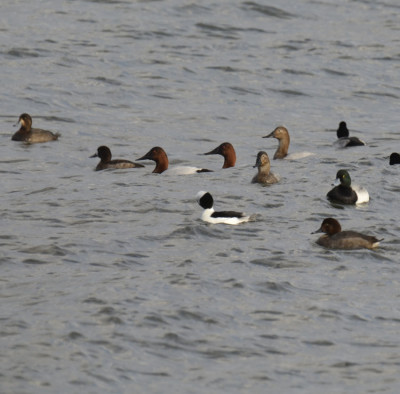While out at LaSalle Marina in Burlington in almost-mid December, I found lots of ducks taking advantage of the ice-free waters. There was a raft of several hundred Scaup quite far out in the harbour. (I still have to count them up from my photos to report them to eBird.) I spent most of my time watching a pair of Bufflehead diving near a feeding Trumpeter Swan but eventually I wandered down the waterfront path to see what other ducks I could find. A group of a hundred or more ducks rising into falling out of view on the crests and troughs of the waves rewarded my curiosity. At first, I thought most of the ducks were Redheads till through the lens the odd narrow sloping bill and head of one of the ducks made me mentally shout “Canvasback!” But were they? What were these ducks with the rusty heads, black fronts and white backs?
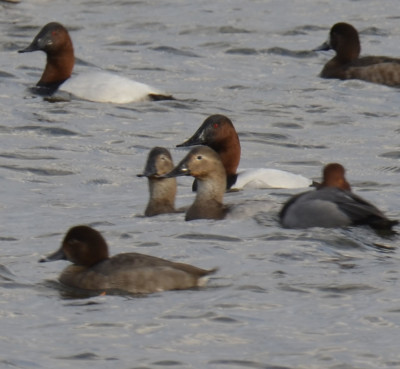
The two white-backed birds and the two “head only” birds in the centre of this photo are Canvasbacks.
A Tale of Two Red-headed Ducks
I’ve seen Redheads before as small numbers of them often over-winter on Lake Ontario near the GTA. Their bright rounded red heads and bluish bills are memorable and attractive especially in the bleaker months when colour is a welcome relief to the ice, steel grey water and snow.
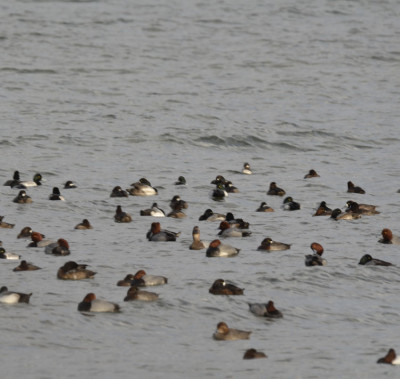
These are almost all Redheads and Scaup.
I have never seen a Canvasback over-winter near the GTA. A quick check on eBird for December-February for the past 10 years shows that there have been Canvasback around but not in large numbers and not often.
The Cornell University website notes that they are only found on Lake Ontario during migration.
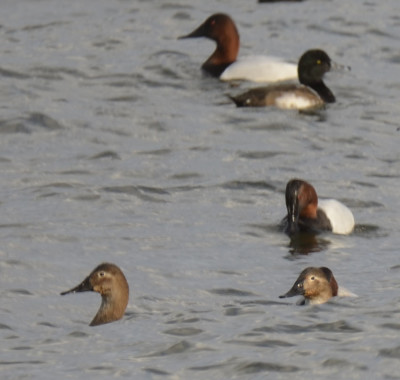
I’m not sure if the “brown” Canvasbacks seen here as disembodied heads are females or juveniles or both. The narrow sloping bill is definitive though.
So I wasn’t really familiar with what one should look like. I just had scanned that page of my field guide so often while looking at Teal and Redheads that I had sort of subliminally absorbed some of the field marks for a Canvasback.
How Can You Tell a Male Canvasback from a Male Redhead?
At a quick glance, male Redheads and male Canvasbacks look superficially similar. They have rusty heads and a vivid black front from where their necks end to where the water covers them up. They have dark feathers near their rear ends. And they are greyish looking on the body.
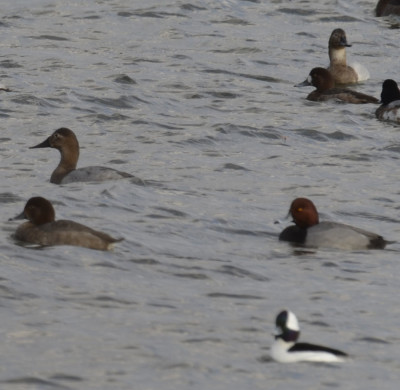
The bird on the upper left is a male Canvasback and to his right is a male Redhead which is behind a male Bufflehead.
As you can see in the photos, though, they really don’t look much alike. Male Canvasback have a much narrower head and a long sloping black bill. Male Redheads have a very rounded head and a blue bill with a dark tip. If the lighting is good, male Canvasbacks have a white back and Redheads have a grey back. Canvasback are also a bit larger.
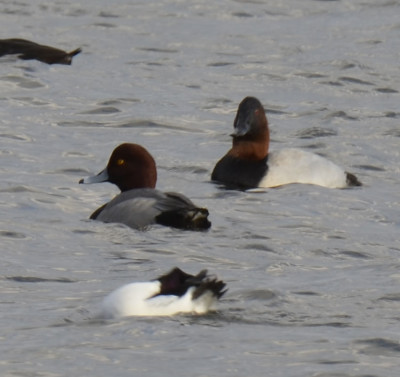
Even when you can’t see the male Canvasback (in the back) in profile, you can see that it is larger than the Redhead, the back is noticeably whiter, the bill is darker and the head is not as round.
The female and juvenile ducks also look quite different because of the shape of their heads and bills.
Why Are They Called Canvasbacks?
After smugly gloating for a while about noticing these new (to me) ducks, I began to wonder why they are called Canvasbacks. Is it something to do with duck hunting and canvas carrying bags?
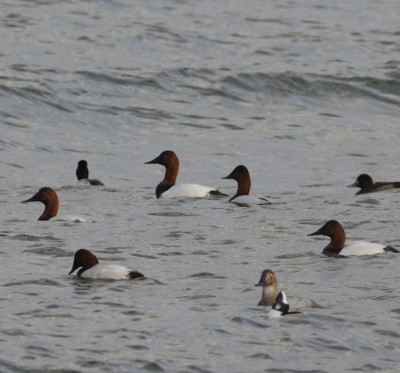
These are mostly Canvasbacks with a male Bufflehead in front and what looks to be a Scaup at the back.
The US Fish and Wildlife Service website suggests two possible reasons.
One involved commercial hunters in the US shipping the ducks from Chesapeake Bay to East Coast restaurants in winter. They sent the birds in cloth bags marked “canvas back” because they wanted the bags shipped back for re-use.
The other possible reason is that they narrowly striped white plumage on the back may have looked like woven fabric to some observers.
In other words, no one is quite sure!
What Do Canvasbacks Eat?
None of the birds I saw was diving. When I checked the Cornell website, I found they normally eat a lot of vegetation including seeds, leaves, tubers and roots. They also eat snails and insect larvae. I’m not sure whether they would eat the zebra mussels and other common crustaceans in Lake Ontario or not.
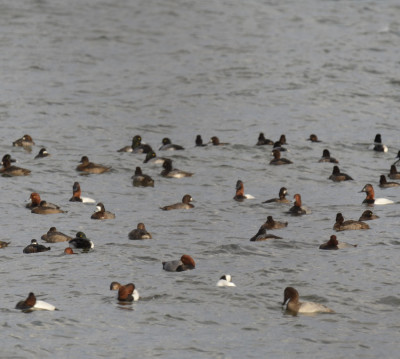
As you can see, it was a mixed flock of Bufflehead, Scaup, Redheads and Canvasback.
One of their major over-wintering sites is Chesapeake Bay where they like to eat an underwater plant called wild celery.
While I didn’t see these interesting birds feeding, I did enjoy a chance to watch them bobbing on the waves. I’ll keep my eyes on any “Redheads” in the future in case there are a few more Canvasbacks camouflaged amongst them!
Related Reading
- What Small Black Duck Has a Big White Spot on Its Head?
- What Black Diving Duck Has a White Comma Near Its Eye?
- Ring-necked Ducks Near Walmart!
- What Is this Crazy Black “Duck” With a White Bill?
Join In
Have you seen Canvasbacks either at their prairie summer nesting homes or on the coast? Please share your sighting with a comment.

